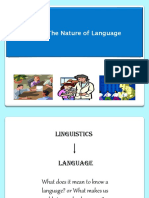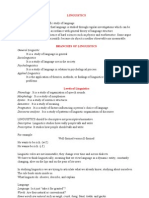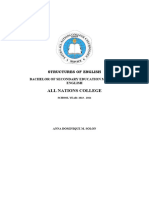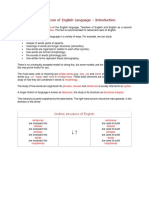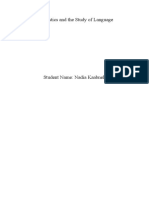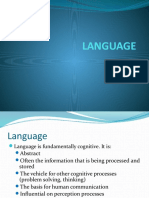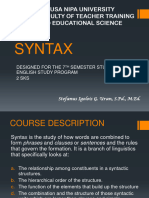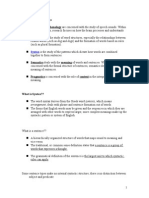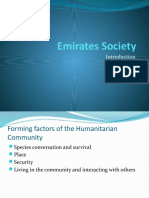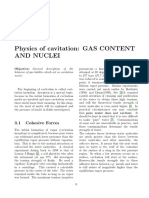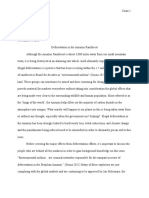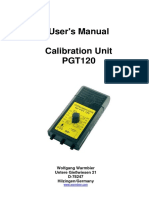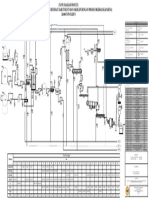NATURE AND STRUCTURE OF LANGUAGE
Definition of Language
• “Language is a symbol system based on pure or arbitrary conventions; infinitely extendable and modifiable
according to the changing needs and conditions of the speakers” – Robins
• “Language is a purely human and non-instinctive method of communicating ideas, emotions and desires by
means of a system of voluntarily produced symbols” - Sapir
Nature of Language
1. Language is Sound : This statement point out the primacy of the languages sounds over the other
representations in writing which are regarded as secondary phenomenon of speech.
2. Language is Linear: Language is represented by using symbols for each sound and arrange them in a
linear succession similar to the sounds production order.
3. Language is Systematic : It is describable in terms of finite number of units that can combine only in a
limited number of ways.
4. Language is System of Systems: Each language has phonological (or sound) system and a grammatical
system, which operates simultaneously.
5. Language is Meaningful: Through the acquisition of language that the child becomes an effective member
of the community.
6. Language is Arbitrary: No direct connection between the nature of things or ideas language deals with and
the linguistic units and combinations by which these things or ideas are expressed.
7. Language is conventional: Language can be said to be conventional as a consequence of apparent
agreement among speakers.
8. Language is a System of Contrasts: What makes single speaker’s habit valid for the speech of a
community is that language is a system of differences.
9. Language is creative: Imaginative manipulation of the standard interlocking of the phonological,
grammatical and lexical systems which extend our awareness.
10. Language is Unique: Each language is unique.
11. Languages are Similar: All languages have certain features in common which open the possibility of
language learning.
Functions of Language
• Informative Function
o The informative function affirms or denies propositions, as in science or the statement of a fact
o This function is used to describe the world or reason about it.
o These sentences have a truth value; that is, the sentences are either true or false. Hence, they are
important for logic.
o The language which includes propaganda of all kinds and even deliberate information is said to be
informative in function.
• Expressive Function
o All expressive language may be analyzed into two component elements – it reports feelings or
attitudes of the writer (or speaker), or of the subject, or evokes feelings in the reader (or listener).
o Poetry and literature are among the best examples, but much of, perhaps most of, ordinary
language discourse is the expression of emotions, feelings or attitudes.
o Expressive discourse, qua expressive discourse, is best regarded as neither true or false.
• Directive Function
o Used for the purpose of causing (or preventing) overt action
o Most commonly found in commands and requests.
o Directive language is not normally considered true or false.
� o Commands and requests can be interchanged by the suitable change in the tone of the voice or in
the expression of the face.
Structure of English Language
• No universally accepted model to study structure of English language.
• There are variety of ways to study structure of language.
Components
Morphology
(Greek ‘Morphos’= Shape or Form)
➢ The study of the structure of words
➢ The smallest units of meaning may be whole simple words (e.g. man, run, big) or parts of complex words
(e.g. un-, -faith- and -ful in unfaithful) which are called morphemes.
➢ Morphology is studied to show how the meaning of a given morpheme, or its relation to the rest of the word,
varies from one complex word to another.
➢ Inflection
➢ A word is changed in its form to show the internal grammar of a sentence. Examples would be plural forms
of nouns (dog + s → dog-s) or past (imperfect) tenses of regular verbs (want + ed → want-ed).
➢ The words in question are inflected i.e. altered by adding a suffix.
➢ Inflectional morphology is much easier to recognize
Nouns Verb Adjective and Adverbs
Addition of terminal s to Ending shows tense Addition of - er → comparative
show plural (one cat; (wanted) or person (hotter; likelier);
two cats); ([she] wants).
Addition of 's to show possession Addition of –est → superlative
(Henry's (coldest; soonest).
cat).
➢ Derivation
➢ Compound or complex words are made by adding together elements without reference to the internal
grammar of a sentence.
➢ The study of such words, "derived" from existing words or morphemes is derivational morphology.
➢ All compound and most complex words show derivational morphology. If a complex word does not show
inflection it will show derivation
➢ A complex word may show both inflection and derivation e.g. deported or disposables
Prefix Base of Word Suffix Complex word
Bi Cycl(e) ing Bicycling
Dis Grace ful Disgraceful
� In Tolera(te) able Intolerable
Re Vision ist Revisionist
Un, co Operat(e) ive, ly Uncooperatively
➢ Parts of Speech (Word Classes)
➢ Words considered as wholes can be categorized according to how they work within phrases, clauses or
sentences. These categories, traditionally called parts of speech are now more usually known as word
classes.
➢ Some classes of words are called closed because they contain a relatively small number of items to which
no new words can normally be added.
➢ Other classes of word are constantly being added to. Each contains a vast number of terms already. They
are open to new words being introduced.
Closed Word Classes
(Structural or Functional)
Determiner Pronoun Preposition Conjunction
a, the, any, my, she, them, who, that, in, across, at, by, and, but, if, or, while,
those, which Himself near, within unless
Open Word Classes
(Lexical)
Noun Verb Adjective Adverb
abstract fear, joy transitive bite, steal descriptive lazy, tall manner reluctantly,
keenly,
easily,
softly
concrete chair, mud intransitive live, cry comparative lazier time soon, often
common boy, town modal can, will, superlative tallest place here, there
may
proper Fred, Hans auxiliary be, have,
do
SYNTAX
➢ In Linguistics, syntax is the set of rules, principles, and processes that govern the structure of sentences in a
given language, specifically word order. The term syntax is also used to refer to the study of such principles
and processes.
➢ It is the study of how words are combined together to form sentences.
➢ Sentence Classification
➢ A Simple Sentence consists of a single independent Clause with no dependent Clauses.
➢ A Compound sentence consists of multiple independent clauses with no dependent clauses. These clauses
are joined together using Conjunctions, punctuation, or both. (and, but, so, etc)
➢ A Complex Sentence consists of one or more independent clauses with at least one dependent clause
(That, if, whether, etc)
➢ A compound-complex sentence consists of multiple independent clauses, at least one of which has at least
one dependent clause. (Coord and subordinators)
➢ SYNTAX: LINEAR ORDER
➢ The most obvious principle of sentence organization is linear order : ‘the words in a sentence must occur in
a particular sequence if the sentence is to convey the desired meaning’
➢ The ordering of the words in sentences determines, in part, whether a sentence is grammatical or not, and
what the sentence means.
� EXAMPLE:
John glanced at Mary.
Mary glanced at John (Different Meaning)
John Mary glanced at. (Non-grammatical)
➢ One of the many rules of English requires that the grammatical subject of a sentence normally precedes the
main verb, which in turn normally precedes its direct object.
➢ She resembles him is English (where she is the subject and him is the object), but resembles she him
and she him resembles are not.
➢ SYNTAX: HIERARCHICAL STRUCTURE
➢ Although linear order is an important principle of sentence organization, sentences are more than just
ordered sequences of words; they have internal hierarchical structure as well.
➢ Individual words in a sentence are organized into natural, semantically coherent groupings, which are
themselves organized into larger groupings, the largest grouping of all being the sentence itself.
➢ These groupings within a sentence are called constituents of that sentence
➢ SYNTAX: HALLIDDAY’S HIERARCHY
➢ The five grammatical units:
1. The Sentence: Composed by one or more Clauses.
2. The Clause: Composed by one or more Phrases.
3. The Phrase: Composed by one or more words.
4. The word: Composed by one or more morphemes.
5. The Morpheme: The smallest unit in form and meaning
SEMANTICS
➢ “Semantics” comes from the Greek ‘semantikos’ which means to show or give signs.
➢ Semantics is the study of meaning of a language.
➢ The study of semantics includes the study of how meaning is constructed, interpreted, clarified, obscured,
illustrated, simplified negotiated, contradicted and paraphrased.
➢ An understanding of semantics is essential to the study of language acquisition and of language change
(how meanings alter over time).
➢ It is important for understanding language in social contexts, as these are likely to affect meaning, and for
understanding varieties of English and effects of style.
➢ It is concerned with the conceptual meaning and not the associative meaning
➢ Semantics in language determines the relationship between signifiers and what they signify
➢ Signifiers have multiple levels of meaning:
o Denotation. It refers to a strictly literal understanding, and the object referred to is known as the
denotata
o Connotation. Various cultural or emotional meanings attached to a word provide one or more
deeper levels of meaning. These subjective meanings are known as connotations
PHONOLOGY
➢ Phonology is the study of how sounds are organized and used in natural languages
➢ Phonology is the study of the way sounds function in languages, including phonemes, syllable structure,
stress, accent, intonation, and which sounds are distinctive units within a language; The way sounds
function within a given language.
➢ PHONOLOGY : BRANCHES
� ➢ 1. Segmental Phonology:- It analyses speech into discrete segments, such as phonemes.
➢ 2. Supra-segmental Phonology:- It analyses those features which extend over more than one segment such
as intonation , stress.
➢ 3. Diachronic Phonology:- It studies the patterns of sound system through the history of language.
➢ 4. Synchronic Phonology:- It studies the patterns of sound regardless of the process of historical change
➢ PHONOLOGY : PHONES
➢ Phone is the smallest , perceptible , discrete segment of sound in the steam of speech i.e. the minimal unit
of speech.
➢ Phones are the physical realization of phonemes.
➢ The speech is segmented and each of the segment is called phone.
➢ Phone are grouped into phonemes through phonemic analysis.
➢ Phone is enclosed within square bracket i.e. [ p ]
➢ PHONOLOGY : PHONEMES
➢ Phoneme is the smallest , distinctive and segmental unit of sound i.e. minimal distinctive unit in the sound
system of a language
➢ Phones are the physical realization of phonemes.
➢ Phoneme is enclosed within slants i.e / p /.
➢ PHONOLOGY : ALLOPHONES
➢ Allophone is a variant of a phoneme. The allophone are very similar to each other ; they do not change the
meaning of a word and they don’t occur in the same phonetic environment.
➢ PHONOLOGY : SYLLABLES
➢ A syllable is a unit of sound composed of :-
– A central peak of sonority (usually a vowel), and
– The consonants that cluster around this central peak
➢ A syllable is a unit of organization for a sequence of speech sounds. For example, the word water is
composed of two syllables: ‘wa’ and ‘ter’. A syllable is typically made up of a syllable nuclear (most often a
vowel) with optional initial and final margins (typically, consonants)
LEXICOGRAPHY
➢ Lexicography is developing as a branch of applied linguistics and there has been a widely felt need of
professionalizing lexicographic work
➢ Lexicography is defined as the editing, compiling, writing or making of a dictionary and includes the
principles and practices of dictionary making.
➢ LEXICOGRAPHY: TYPES
➢ PRACTICAL LEXICOGRAPHY. - The art or craft of compiling, writing and editing dictionaries
➢ THEORETICAL LEXICOGRAPHY. -The scholarly discipline of analyzing and describing the semantic,
syntactic and paradigmatic relationships within the lexicon (vocabulary) of a language. It is concerned with
developing theories of dictionary components and structures linking the data in dictionaries.
➢ PRACTICAL LEXICOGRAPHY: SCOPE
➢ Shaping the intended users
➢ Selecting and organizing the components of the dictionary
➢ Selecting words and affixes for systemization as entries
➢ Selecting collocations, phrases and examples
➢ Defining words
➢ Organizing definitions
Specifying pronunciations of words


